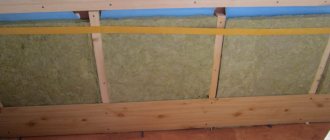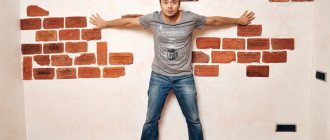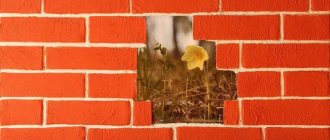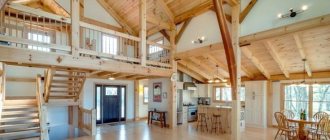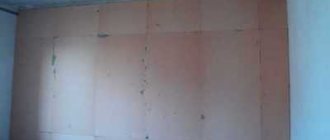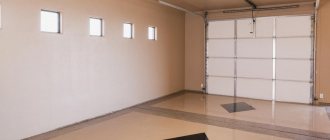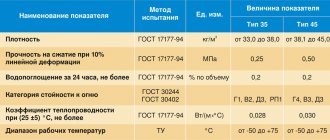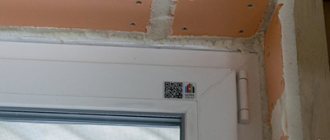In private housing construction, brick buildings are positioned as structures that will last for centuries, which will become a family nest for subsequent generations. There is a certain reason for this, a brick house is really strong and reliable, but its heat saving indicators lag behind modern requirements. Taking into account rising energy prices, heating a brick house, even with mains gas, is quite expensive. If it is not possible to install thermal insulation from the outside, you need to decide how to properly insulate brick walls from the inside of the building.
Features of brick walls
The undeniable advantages in strength and rigidity of brick houses are outweighed by their insufficient thermal efficiency. The standard thickness of masonry for heat conservation for the 2nd climate zone is 64 cm, i.e. 2.5 bricks, while sufficient strength for 1-2 storey buildings is provided by masonry of 1 brick, and up to 5 floors inclusive of 1.5 bricks.
Achieving standard energy efficiency of a house by increasing the thickness of brick walls will increase the cost of construction due to an increase in the amount of material and the amount of work. The increased weight of the structure will require a more powerful foundation. Brick buildings are thermally inert: they take a long time to warm up and take a long time to cool down.
Important! There is a direct relationship between the thickness of the brickwork and its thermal inertness. The thicker the wall, the longer it will take to warm up and the longer it will give off heat.
Temperature inertia is an undeniable plus for permanent residence buildings, but for country cottages where people come for the weekend, it is a minus: by the time the house heats up, the weekend will end. Frequent heating and cooling cycles negatively affect the integrity of the walls. The best method of increasing the energy efficiency of a brick house is its external insulation. If it is impossible to install insulation from the outside, it is allowed to insulate a brick wall from the inside, subject to the rule of increasing the vapor permeability coefficient from the inside to the outside.
What is the best way to insulate?
Proper insulation of brick walls is the key to reliable thermal insulation and preservation of a comfortable climate in a living space. It is not recommended to insulate a brick wall from the inside, since the outer wall will constantly freeze and thaw, which will cause cracks to appear, which will gradually begin to increase and destroy the structure. Vapor permeability will also decrease significantly, as a result the room will always be cold and damp, and the heat in the room will not linger.
Therefore, it is advantageous to insulate brick houses from the outside. If the installation work is carried out correctly, the outer wall will be reliably protected from temperature changes and moisture, due to which the heat inside the room will remain preserved and excess moisture will dry out. In addition, the structure of the house will not be damaged by the formation of cracks, which is also important for maintaining a comfortable climate and coziness in the house.
Rules for insulating brick walls
When planning the construction of a brick house, include insulation for the brick wall inside the masonry in the estimate. Polystyrene foam, extruded polystyrene foam or PIR boards can handle this role. If the house has already been built, it is optimal to insulate it from the street side, but this is not always possible. Installation of the external insulating layer can include:
- the presence of permanent exterior finishing;
- proximity to a fence or other building;
- historical or architectural value of the building.
Important! The Town Planning Code does not allow the outside of apartments in multi-storey buildings to be insulated, because... this entails a change in the appearance of the building.
Insulation of internal walls is the only option to increase heat saving if it is impossible to install insulation outside or inside the load-bearing walls of the house. If the area of a country house allows the use of slab material without compromising the size of the rooms, then the corner room of the apartment can be insulated either with penofol or warm plaster, which, due to their insignificant thickness, will not lead to a significant reduction in usable area.
One of the negative aspects of insulating internal walls is freezing of the outer wall due to lack of heating from the inside. But it is not so much freezing that harms structures, but moisture condensing on a cold surface. High humidity leads to the formation of mold and mildew, which negatively affects human health and the integrity of structures. To minimize the appearance of moisture in the insulation, you must follow the principle of increasing the vapor permeability coefficient of materials from the inside out.
Dew point
According to professional builders, it is better to do insulation from the outside. Only in exceptional situations can thermal insulation be installed indoors. The main reason for such caution is the position of the dew point with improper insulation.
Note: red brick is more resistant to moisture than silicate brick . Houses made of white brick will have to be protected from getting wet with a vengeance: protected from precipitation outside and condensation accumulation inside.
Dew point position
If you consider different insulation options, you will notice the following patterns:
- When placing a heat-insulating layer on the outside, the entire wall remains protected from precipitation and freezing in winter. Steam leaves the room without any problems without moistening the supporting structures.
- When placing insulation inside, the dew point shifts towards the inner surface of the walls or into the thickness of the structure. As a result, the house becomes damp, mold forms and the supporting structures of the building slowly collapse.
Requirements for insulation for interior work
When choosing a heat-insulating material, you need to take into account not only its heat-saving ability. The following qualities are important:
- ease of installation;
- environmental cleanliness;
- non-flammability;
- no harmful emissions when the temperature rises.
With a small area of the insulated room, slab material 50 mm thick plus a ventilation gap will lead to a smaller room. In this case, it is permissible to use penofol, which combines the functions of insulation and vapor barrier material.
Important! the foil surface of penofol works to reflect thermal radiation only if there is a gap between the insulation and the finish.
Thermal panels
This material is distinguished by both thermal insulation and the ability to cover the surface of walls..
Characteristics:
- thermal conductivity – 0.025 W/(mK);
- impermeability – 45-55 kg/m3.
PLEASE ATTENTION! Today on the market you can find panels that are produced as an imitation of siding or lining. They are covered with a special quartz coating.
Thermal panels
Material selection criteria
To understand how to properly insulate a brick wall from the inside, decide who will install the insulation. Professionals know what materials are combined with each other and how to avoid cold bridges. When doing the work yourself, use a special calculator to calculate where the dew point will be in the insulation pie. It must be moved as far as possible to the outer surface of the enclosing structure. The dew point in the insulation will cause it to become wet and reduce its thermal insulation properties.
What does this look like in practice?
Now let's look at how to insulate a brick house from the inside, in practice.
If you chose expanded polystyrene, then your insulation is quite dense, 20-40 mm, and you can glue it directly to the wall. The denser part faces the inside of the house, as you remember, and then it can be finished off: wallpapering, plastering. By the way, if you are not insulating a house, but, for example, a bathhouse, but also made of brick, extruded polystyrene foam and other polymer materials will not be suitable here, since when significantly heated they will release toxic substances into the air. When insulating walls from the inside, start by treating the walls: they need to be leveled and primed with an antiseptic composition, which will guarantee the absence of fungi on the wall. Armed with regular tile adhesive or a special one for polystyrene foam, apply the adhesive composition with a notched trowel onto slabs that have been previously rolled with a needle roller, which will significantly improve adhesion. Glue the slabs tightly to each other, make a vertical spread between the seams of the rows. Wait until the glue dries, then fill all the resulting seams with silicone-based sealant. You must achieve maximum vapor tightness. You can cover the resulting surface with wallpaper, for which an aqueous solution of PVA glue will be sufficient. But if you want the inside of the house to have structural plaster, then you also need to reinforce the surface with fiberglass mesh, for which the same glue is suitable, and after the mesh has dried, proceed to decorative finishing.
Types of thermal insulation materials
If the homeowner has basic construction skills, the question of how to cheaper insulate the brick walls of a house from the inside is solved by saving on wages for hired workers. Study the types and properties of modern insulation and do the work yourself.
Mineral wool
An effective heat insulator, produced in the form of plates and rolls. To insulate the walls of a brick house, it is necessary to use slab varieties. Mineral wool in rolls is intended for installation on horizontal surfaces; vertical placement of rolled mineral wool will lead to its slipping and a decrease in thermal efficiency. To insulate walls, choose insulation with a density of at least 35 kg per m3. Advantages of mineral wool:
- affordable price;
- environmental cleanliness;
- non-flammability;
- light weight;
- ease of installation;
- energy efficiency.
Attention! When working with mineral wool, you must use protective clothing, goggles, gloves, and a respirator.
The disadvantages of the material include its dustiness and the need to install a vapor barrier on the side of the warm room. When installed in interior partitions, mineral wool improves sound insulation.
Expanded polystyrene
Lightweight and cheap material with high thermal insulation ability. Has high vapor permeability. The disadvantages include:
- flammability;
- release of toxic substances when temperature rises.
Extruded polystyrene foam does not support combustion, but when heated it emits toxic fumes. The low vapor permeability of EPS allows it to be installed without a vapor barrier film.
Note! Both types of PPS are not recommended for insulating baths, saunas and other high-temperature rooms .
Warm plaster
A cement-based mixture containing additives from expanded clay, perlite, expanded polystyrene and other substances that help insulate brick walls due to their insulating properties. Warm plaster for interior work is the optimal answer to the question of how to insulate a corner apartment. The insulating layer of plaster is applied similarly to a conventional mixture, no more than 4-5 cm thick. The absence of cold bridges, ease of application and subsequent finishing will allow you to insulate an apartment in a brick house from the inside.
Important nuances
Before you insulate the walls in a brick house, you need to take into account certain features of the process and understand what they are.
In order to choose the right thermal insulation material, taking into account its technical characteristics, you should study a number of physical processes associated with this type of work.
The word “insulation” means a change in the performance of buildings in terms of thermal conductivity. A high reading indicates that a low quality thermal insulator was used and should no longer be used. Such work is carried out using insulating materials with a low level of thermal energy conductivity.
We know that brick stone is made from baked clay, which conducts heat well. A structure built from such material and without an insulating layer warms up and cools down quite quickly, and its temperature regime depends on the surrounding air. Note that clay has a porous structure and perfectly absorbs water, which under appropriate conditions tends to evaporate.
During the process of water evaporation, the temperature of the surface exposed to this phenomenon decreases. It turns out that a house made of brick stone, which is not a warm object anyway, cools down even more during evaporation. Using this property, on hot days you can cool a brick building that does not have insulation by opening access to the basement. The damp air flow rising from it fills the bricks with moisture, which gradually evaporates out. This process is comparable to the operation of an air conditioner.
Let's figure out how the insulation works correctly. In the material used for interior decoration, the movement of air masses is difficult. The air gap is a kind of barrier to heat flows. This principle is inherent in the design of a conventional thermos and double-glazed windows.
Effective protection against thermal energy loss is created by a layer of air located between the walls made of a special substance. The thermal insulation capabilities of the insulation, which are taken into account when purchasing the material, depend on the number of such interlayer partitions.
Insulating a brick house from the inside using modern methods shifts the dew point (this is the conventional name for the place where warm air is converted into condensation that accumulates inside) deeper inside the wall structures. It is necessary to move such a point outward as much as possible, away from the middle of the wall.
Such conditions can be achieved by insulating the walls from the inside. Naturally, such a solution will reduce the usable space of the room, which will greatly affect rooms with small areas. And yet, what is the best way to insulate walls from the inside?
Main stages of installation
Do-it-yourself insulation of a private brick house from the inside begins with installing sheathing to match the size of the slab material. When insulating EPS or EPS, you can use wooden blocks or guides for drywall, installing them at a distance corresponding to the width of the insulation boards. For mineral wool, the distance between the sheathing elements is calculated by subtracting 1-2 cm from the width of the material for a more dense installation of the insulation. If PPS or EPS is chosen as thermal insulation, after installing them it is necessary to foam the cracks, if any. After installing the expanded polystyrene, you need to secure a layer of vapor barrier along the sheathing, gluing the seams with special tape.
Important! Ordinary tape, even double-sided tape, is not a substitute for vapor barrier tape .
When working with extruded polystyrene foam, a vapor barrier is not required. Mineral wool insulation also requires a layer of vapor barrier. The final finishing can be lining or imitation timber. Before installing the wooden planks, it is necessary to secure the counter-lattice for the ventilation gap. When finishing with plasterboard, a ventilation gap is not required.
Note! Penofol can be used as a vapor barrier.
When should you insulate?
The need for insulation is relevant for owners of private brick houses and apartments, because prices for coolants are constantly increasing, and if the room is large, then heating it and retaining heat becomes much more problematic. Insulation work is especially necessary when the living space is built with one brick, and the thickness of the wall is so small that in winter it freezes through. It is not difficult to decorate a brick wall with insulation and carry out facade work with your own hands; it is important to correctly calculate and select the finishing material.
The best period for insulating an apartment or house is the warm, dry season.
Advice from professionals
Professionals know the secrets of their craft and are ready to share them with those who insulate the house themselves:
- When choosing insulation, its thickness and installation method, calculate the energy efficiency of the wall pie in accordance with the climate zone.
- When installing the sheathing, control the work with a building level. A leveled sheathing will make it easier to install the finishing touches.
- Use dry lumber.
- Having purchased compressed mineral wool, unpack it a day before installation.
- Follow the manufacturer's recommended vapor barrier overlap.
- Tape the foam joints with aluminum tape.
- Follow the material manufacturer's recommendations.
Internal insulation of the walls of a brick house using vapor barrier materials prevents the removal of moisture from the room. Take a carbon dioxide level measurement. Exceeding the standard indicates low efficiency of the ventilation system.
When is it not possible to insulate the outside?
Ideally, place a layer of insulation on the outside of the building along its facade. But owners do not always manage to implement this option. There may be several reasons for this:
- the facade of the house is prohibited from changing due to its historical value (the situation is typical for old brick apartment buildings);
- insulation work must be carried out at high altitudes, and the owners do not have the opportunity to turn to professional builders;
- the distance between neighboring houses is too small to allow working with external walls.
In all of the above cases, you will have to resort to internal insulation. The main task in such a situation is to avoid the harmful effects of condensation on the insulation.
There are two common ways to solve this:
- When using mineral (basalt) wool, the vapor barrier film is overlapped, and all seams are carefully taped.
- When using materials with very low permeability, you can abandon the vapor barrier film, since the insulation does not get wet. As such a material, you can choose expanded polystyrene or penofol with a foil layer.
A few words about waterproofing and vapor barrier
At the stage of thermal insulation of the wall, it is necessary to pay special attention to the vapor barrier, otherwise the insulating material will become unusable after some time. The classic material for vapor barrier is polyethylene.
When installing, you must handle it extremely carefully and do not pull it too hard, otherwise the film may become deformed, especially during seasonal changes in climatic conditions.
Waterproofing
A frequently used vapor barrier material is considered to be mastics specially created for this purpose. If they are applied to the wall, they will allow air to pass through while retaining moisture. Waterproofing protects various building structures from moisture penetration. It is easy to apply, does not require special qualifications from workers, and does not form seams.
For brick walls, plaster is often used instead of vapor barrier, which is not very true in the case of mineral wool, because the insulation will begin to dampen.
Vapor barrier and waterproofing
We form a multilayer coating:
- The initial coating has a liquid consistency, formed on the basis of a sand-cement mortar. The thickness does not exceed 1 cm. The main task of application is to eliminate the smallest defects present on the masonry from the inside;
- Primer – has a dough-like consistency and is applied in 3 layers with a total thickness of up to 6 cm. It is necessary to dry each layer;
- The final coating is characterized by a liquid consistency and is applied in a layer 5 centimeters thick. The basis of the coating will be carefully sifted fine sand. The main purpose of application is to create a perfectly smooth surface.
"Thermofix" - the optimal choice of plaster
The optimal option for warm plaster would be “Thermofix”, which has excellent performance characteristics due to the porous structure created from foamed polystyrene.
The product does not require additional use of a primer, but is applied to a surface previously moistened with water. By correctly applying the mortar to the brick, you will receive the following characteristics
- High level of thermal conductivity;
- Good diffusion resistance;
- Low water absorption;
- Excellent adhesive strength;
- Increased density of the hardening solution.
Finishing
All that remains is to cover the frame with sheet material - boards, plastic panels, chipboards or plasterboard.
The heads of the self-tapping screws with which the sheathing is screwed to the frame are immersed into it by about 1 mm.
After this, the wall is puttied (particular attention should be paid to the joints between the individual sheets) and painted or covered with wallpaper.
People who are poorly versed in construction issues can carry out internal insulation of a house without a second thought. However, in most cases this is not advisable. Is it possible to insulate a house from the inside? Let's look at the arguments for and against.
The technology for making ecowool with your own hands is described in detail in this article.
Vapor barrier film
Using mineral wool from the inside, you need to take care of the vapor barrier coating. The optimal choice would be Izospan RS, used to protect walls and ceilings from the inside of the room. The use of the product will prevent the formation and accumulation of condensation, which has a destructive effect on the insulation.
The product is produced in the form of a waterproofing film, which ensures the preservation of thermal insulation characteristics and extends the service life of the structure as a whole. The masonry is not exposed to corrosion and is not infected with fungus.
DIY thermal insulation process
The technology depends on the type of material chosen. Regardless of this, a unified technique is used, which includes preliminary preparation of the brick, which is cleaned of dirt and dust.
Plastering walls begins with preparatory activities. It is necessary to remove the old, cracking and peeling coating, clearing the masonry of dust.
After this, thin slats (5 mm) should be fixed to the partition, forming a gap between the surface and the reinforcement mesh (5 cm cells). Reinforcement is performed over the entire area followed by application of the solution. It is necessary to prevent the formation of cracks.

